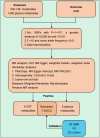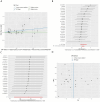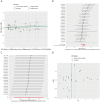Identification of 7-HOCA as a Potential Biomarker in Glioblastoma: Evidence from Genome-Wide Association Study and Clinical Validation
- PMID: 39691836
- PMCID: PMC11651077
- DOI: 10.2147/IJGM.S493488
Identification of 7-HOCA as a Potential Biomarker in Glioblastoma: Evidence from Genome-Wide Association Study and Clinical Validation
Abstract
Purpose: Glioblastoma (GBM) is associated with metabolic disturbances, yet the relationships between metabolites with GBM have not been comprehensively explored. This study aims to fill this gap by integrating Mendelian randomization (MR) analysis with clinical validation.
Patients and methods: Summary data from genome-wide association study (GWAS) of cerebrospinal fluid (CSF) metabolites, plasma metabolites, and GBM were obtained separately. A total of 338 CSF metabolites and 1400 plasma metabolites were utilized as exposures. Concurrently, GBM was designated as the outcome. A two-sample bidirectional MR study was conducted to investigate the potential association. The inverse variance weighted (IVW) analyses were conducted as causal estimates, accompanied by a series of sensitivity analyses to evaluate the robustness of the results. Additionally, metabolite levels in clinical plasma and CSF samples were quantified using liquid chromatography-mass spectrometry to validate the findings.
Results: MR analysis identified eight CSF metabolites and six plasma metabolites that were closely associated with GBM. Among these, elevated levels of 7-alpha-hydroxy-3-oxo-4-cholestenoate (7-HOCA) in both CSF and plasma were found to promote GBM. In terms of clinical validation, compared to the control group, 7-HOCA levels were significantly higher in both the CSF and plasma of GBM group.
Conclusion: This study provides a comprehensive analysis of the metabolic factors contributing to GBM. The identification of specific metabolites, particularly 7-HOCA, that have vital roles in GBM pathogenesis suggests new biomarkers and therapeutic targets, offering potential pathways for improved diagnosis and treatment of GBM.
Keywords: 7-alpha-hydroxy-3-oxo-4-cholestenoate; Mendelian randomization; cerebrospinal fluid; glioblastoma; metabolite; plasma.
© 2024 Zhao et al.
Conflict of interest statement
The authors report no conflicts of interest in this work.
Figures






Similar articles
-
The causal relationship between CSF metabolites and GBM: a two-sample mendelian randomization analysis.BMC Cancer. 2024 Sep 9;24(1):1119. doi: 10.1186/s12885-024-12901-7. BMC Cancer. 2024. PMID: 39251963 Free PMC article.
-
Deciphering the causal relationship between plasma and cerebrospinal fluid metabolites and glioblastoma multiforme: a Mendelian Randomization study.Aging (Albany NY). 2024 May 10;16(9):8306-8319. doi: 10.18632/aging.205818. Epub 2024 May 10. Aging (Albany NY). 2024. PMID: 38742944 Free PMC article.
-
Mediation Mendelian randomization analysis of immune cell phenotypes and glioma risk: unveiling the regulation of cerebrospinal fluid metabolites.Discov Oncol. 2025 May 9;16(1):712. doi: 10.1007/s12672-025-02499-y. Discov Oncol. 2025. PMID: 40343558 Free PMC article.
-
Causal association between cerebrospinal fluid metabolites and Parkinson's disease: A two-sample bidirectional mendelian randomization study.Behav Brain Res. 2025 Mar 28;482:115426. doi: 10.1016/j.bbr.2025.115426. Epub 2025 Jan 8. Behav Brain Res. 2025. PMID: 39793738
-
Plasma proteins, circulating metabolites mediate causal inference studies on the effect of gut bacteria on the risk of osteoporosis development.Ageing Res Rev. 2024 Nov;101:102479. doi: 10.1016/j.arr.2024.102479. Epub 2024 Aug 28. Ageing Res Rev. 2024. PMID: 39214170 Review.
References
LinkOut - more resources
Full Text Sources
Miscellaneous

